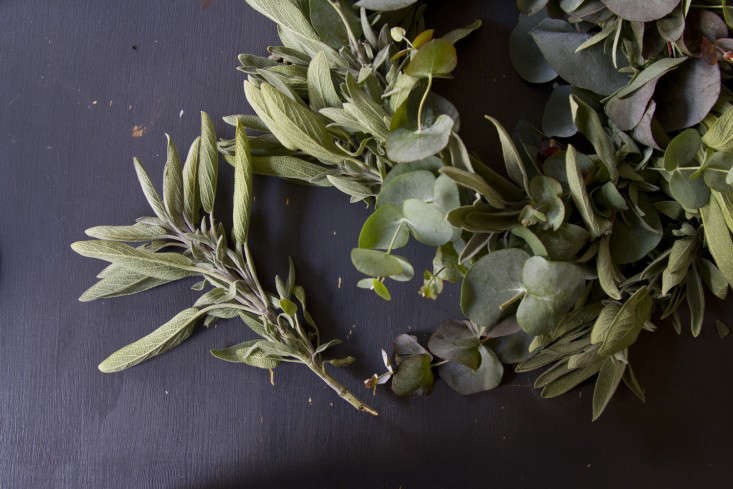Sage, Salvia officinalis: “Cook’s Choice”
Common sage belongs to the Salvia genus and one thing that differentiates the herb from other salvias also called sage is how delicious it tastes as an ingredient in Thanksgiving stuffing.
While you may not want to use sage the way it’s been used in centuries of yore–for snake bites and protection from the plague–you could still let this unassuming perennial take center stage. Without further ado, a plethora of uses for the culinary and ornamental herb:
Above: Bundles of sage leaves, interspersed with eucalyptus, make a fragrant holiday wreath. Photograph by Erin Boyle. For more, see DIY on a Budget: A Silvery Holiday Wreath for $20.
To grow your own, simply select seeds or cuttings. Plant in a sunny spot in your garden, and step back. Sage loves dry conditions, so don’t over-water. Once or twice a season, spread compost or compost tea around your plant, and enjoy your sage in any number of ways for four to five years.
Above: Photograph by Irene Grassi via Flickr.
Cheat Sheet
- Plant near cabbage, carrots, rosemary and other aromatic herbs, but avoid planting near cucumbers.
- Very fragrant leaves. Excellent for use as background color or edging in herb, vegetable, or flower gardens.
- Small, tight spikes of flowers in mid-summer are very attractive to birds and bees. Requires little care once grown, except for harvesting.
Keep It Alive
- Sage enjoys full sun; plant cuttings in late winter or early spring.
- Give sage even moisture while it is being established; do not over-water mature plants.
- Grow sage indoors, outdoors, and as a ground cover.
Above: Sage (at L) is a delicious seasoning to add to roasted root vegetables. See more in Garden to Table: Holiday Menu with Laura Silverman. Photograph by Laura Silverman.
Try sage layered in stuffings and sauces, especially combined with fatty meats like lamb or beef chuck. Sage imparts peppery, smoky, musky, earthy flavor, often with a hint of camphor, lemon, or pineapple, depending on the variety. Adding sage to a hair rinse can help to keep dyed from fading back to gray, and planting it in any area of your garden can ward off pesky insects and increase the flavor and stamina of veggies. Sage can be dried, bundled, and burnt as a protective incense in your living space, as is done in sacred tradition in cultures world over.
Planning now for an early spring herb garden? See our posts on Shade-Tolerant Herbs to Grow in Your Apartment and Small Space Gardening: A Kit to Grow Windowsill Herbs.
Finally, get more ideas on how to successfully plant, grow, and care for sage with our Sage: A Field Guide.
Interested in other edible plants for your garden? Get more ideas on how to plant, grow, and care for various edible plants (including flowers, herbs and vegetables) with our Edible Plants: A Field Guide.















Have a Question or Comment About This Post?
Join the conversation (0)